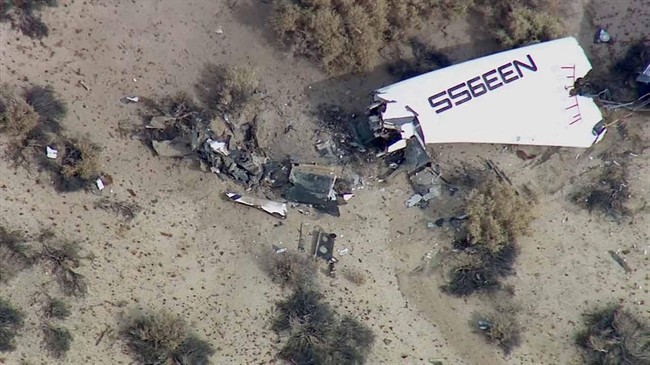WATCH: Investigators are now looking at human error as the possible cause of the Virgin Galactic spaceship that crashed on a test flight last week, killing one pilot. The company is rushing to reassure potential customers who dream of one day travelling into space. Jackson Proskow reports.

LOS ANGELES – Federal investigators say they have determined that a space tourism rocket broke apart in flight over California’s Mojave Desert after a device to slow the experimental spaceship’s descent deployed too soon.
National Transportation Safety Board Acting Chairman Christopher Hart said that while no cause for Friday’s crash Virgin Galactic‘s SpaceShipTwo has been determined, investigators found the “feathering” system – which rotates the tail to create drag — was activated before the craft reached the appropriate speed.
The system requires a two-step process to deploy. The co-pilot unlocked the system but Hart said the second step occurred “without being commanded.”
WATCH: Virgin Galactic founder, Richard Branson on Monday told British broadcaster Sky News that the company will “move forward” despite the crash on Friday of a prototype spacecraft, that killed one of two test pilots.
“What we know is that after it was unlocked, the feathers moved into the deploy position and two seconds later we saw disintegration,” Hart said.
The finding moves away from initial speculation that an explosion brought down the craft, but still doesn’t fully explain why the disaster occurred.

Get breaking National news
The investigation is months from being completed and pilot error, mechanical failure, the design and whether there was pressure to continue testing are among many things being looked at, Hart said.
“We are not edging toward anything, we’re not ruling anything out,” Hart said. “We are looking at all these issues to determine the root cause of this accident.”
READ MORE: Virgin Galactic founder Branson vows to find cause of deadly spacecraft crash
The co-pilot Michael Alsbury, 39, was killed. Peter Siebold, 43, who piloted the mission, parachuted to the ground and is receiving treatments at a hospital for serious injuries.
Hart said investigators have not interviewed the pilot because of his medical condition.
Virgin Galactic — owned by billion Richard Branson’s Virgin Group and Aabar Investments PJS of Abu Dhabi — plans to fly passengers to altitudes more than 100 km above Earth. The company sells seats on each prospective journey for $250,000.
Branson had hoped to begin flights next year but said Saturday that the project won’t resume until the cause of the accident is determined and the problems fixed.
Hart said a review of footage from a camera mounted to the ceiling of the cockpit shows the co-pilot moving the feathering lever to the unlock position.
The feathering is a feature unique to the craft to help it slow as it re-enters the atmosphere. After being unlocked, a lever must be pulled to rotate the tail section toward a nearly vertical position to act as a rudder. After decelerating, the pilots reconfigure the tail section to its normal position so the craft can glide to Earth.
READ MORE: Private Spaceflight industry shaken after Virgin Galactic crash
Hart said the feathers activated at Mach 1.0, the speed of sound or 1,223 km/h. They shouldn’t have deployed until the craft had at least reached a speed of Mach 1.4, or more than 1,610 km/h.
SpaceShipTwo tore apart Friday about 11 seconds after it detached from the underside of its jet-powered mother ship and fired its rocket engine for the test flight. Initial speculation was that an explosion occurred but Hart said the fuel and oxidizer tanks and rocket engine were found and showed no sign of being burned or breached.

Virgin Galactic CEO George Whitesides issued a statement Sunday to tamp down conjecture about the cause of the crash.
“Now is not the time for speculation,” he said. “Now is the time to focus on all those affected by this tragic accident and to work with the experts at the NTSB, to get to the bottom of what happened on that tragic day, and to learn from it so that we can move forward safely with this important mission.”
SpaceShipTwo has been under development for years and, like all space projects, has suffered setbacks. In 2007, an explosion killed three people on the ground and critically injured three others during a ground test in the development of a rocket engine.

Comments